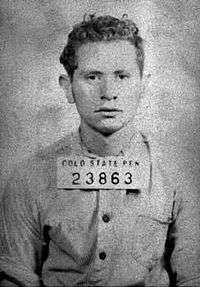Harvey Glatman
Harvey Murray Glatman (December 10, 1927 – September 18, 1959) was an American serial killer active during the late 1950s. He was known in the media as "The Lonely Hearts Killer" and "The Glamour Girl Slayer". He would use several pseudonyms, posing as a professional photographer to lure his victims with the promise of a modelling career.
Harvey Glatman | |
|---|---|
 Glatman's 1958 mugshot | |
| Born | Harvey Murray Glatman December 10, 1927 The Bronx, New York, U.S. |
| Died | September 18, 1959 (aged 31) San Quentin, California, U.S. |
| Cause of death | Execution by gas chamber |
| Nationality | American |
| Other names | The Glamour Girl Slayer The Lonely-Hearts Killer |
| Conviction(s) | Kidnapping Murder Robbery |
| Criminal penalty | Death penalty |
| Details | |
| Victims | 3 known + 1 suspected |
Span of crimes | August 1, 1957 – July 13, 1958 |
| Country | United States |
| State(s) | California, possibly Colorado |
Date apprehended | October 31, 1958 |
| Imprisoned at | New York State Reception Center in Almira, Sing Sing Correctional Facility and San Quentin State Prison |
Early life
Born in the Bronx to a Jewish family and raised in Colorado, Glatman exhibited antisocial behavior and sadomasochistic sexual tendencies from an early age. When he was twelve years old, his parents noticed that he had a red, swollen neck. He described having been in the bathtub, placing a rope around his neck, running it through the tub drain, and pulling it tight against his neck," achieving some kind of sexual pleasure from this act." His mother took him to the family physician and was told he "would grow out of it."[1]
Murders
Glatman moved to Los Angeles, California, in 1957 and started strolling around modeling agencies looking for potential victims. He would contact them with offers of work for pulp fiction magazines, take them back to his apartment, tie them up and sexually assault them, taking pictures all the while. He would then strangle them and dump the bodies in the desert. His two known model victims were Judith Dull and Ruth Mercado.[2] A third victim, Shirley Ann Bridgeford, was met through a Lonely Hearts ad in the newspaper.
Glatman also is a suspect in the slaying of "Boulder Jane Doe," a victim whose corpse was discovered by hikers near Boulder, Colorado in 1954.[3] Her identity remained a mystery for 55 years. In October 2009, the Sheriff's Office was notified by Dr. Terry Melton, of Mitotyping Technologies in State College, Pennsylvania that her lab had made a match between the Jane Doe's DNA profile and that of a woman who thought the unidentified murder victim might be her long-lost sister.[4] The positive identification of "Boulder Jane Doe" was an 18-year-old woman from Phoenix, Arizona named Dorothy Gay Howard.[5][6]
Arrest and execution
Glatman was arrested in 1958, caught in the act of kidnapping what would have been his fourth known murder victim, Lorraine Vigil.[7] A patrolman saw him struggling with a woman at the side of the road and arrested him.[8] He willingly confessed to his three murders and eventually led the police to a toolbox containing pictures that he had taken of the victims.[9]
He was found guilty of two counts of first-degree murder and sentenced to death, a sentence that he accepted willingly. He specifically asked the warden to do nothing to save his life. He was executed in the gas chamber of San Quentin State Prison on September 18, 1959.[10]
Media
- Parts of Glatman's career were fictionalized by Jack Webb in 1966 for the two-hour television movie Dragnet, starring his character Sgt. Joe Friday. The film convinced NBC executives to relaunch Dragnet as a TV series in 1967 for a four-year run, although the movie itself was not aired until 1969.[11] Some of the dialogue was reportedly drawn from Glatman's own statements to police, for example:
- Suspect: "The reason I killed those girls was 'cause they asked me to. (pause) They did; all of them."
- Sgt. Friday: "They asked you to?"
- Suspect: "Sure. They said they'd rather be dead than be with me."
LAPD Captain Pierce Brooks, who was involved in Glatman's arrest and interrogation, served as a technical advisor for the film.[12]
- Glatman was referenced by name in Episode 2, Season 2 of the Netflix show, Mindhunter.
References
- "Archived copy" (PDF). Archived (PDF) from the original on 2018-10-06. Retrieved 2009-06-26.CS1 maint: archived copy as title (link)
- "Murderer Confesses". The Daily Chronicle. DeKalb, Illinois. November 1, 1958. p. 6.
- "BOULDER JANE DOE (Someone's Daughter: In Search of Justice for Jane Doe)". Silvia Pettem. Archived from the original on 2014-08-20. Retrieved 2014-08-20.
- "News & Media". Bouldercounty.org. Archived from the original on 2010-05-27. Retrieved 2014-08-20.
- Anas, Brittany (2009-10-28). "Mystery solved: Boulder sheriff IDs 'Jane Doe' as Dorothy Gay Howard - Boulder Daily Camera". Dailycamera.com. Archived from the original on 2014-08-21. Retrieved 2014-08-20.
- "Dorothy Gay "Dot" Howard (1936-1954) - Find A..." www.findagrave.com. Archived from the original on 11 January 2016. Retrieved 26 March 2018.
- Union-Tribune, San Diego. "November 1, 1958: Killer retraces trail". sandiegouniontribune.com. Archived from the original on November 5, 2018. Retrieved 2018-11-05.
- Birnes, William J.; Keppel, Robert D. (2008). Serial Violence: Analysis of Modus Operandi and Signature Characteristics of Killers. CRC Press. p. 20. ISBN 9781420066333.
- "Sex Killer Dies in Gas Chamber". The Los Angeles Times. 1959. Archived from the original on December 6, 2017. Retrieved November 4, 2018.
- "Sex Killer Dies in Gas Chamber". The Los Angeles Times. 1959. Archived from the original on December 6, 2017. Retrieved November 4, 2018.
- Hayde, MJ. My Name's Friday: The Unauthorized But True Story of Dragnet and the Films of Jack Webb. Cumberland House (2001), pp. 178-9. ISBN 1581821905
- Hayde (2001), p. 177.